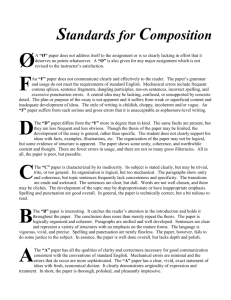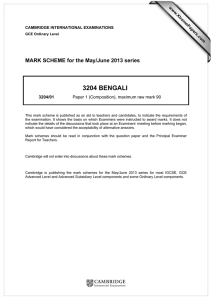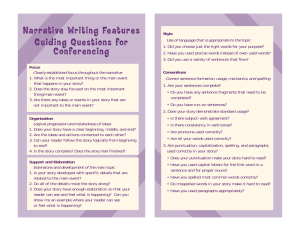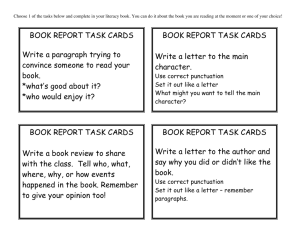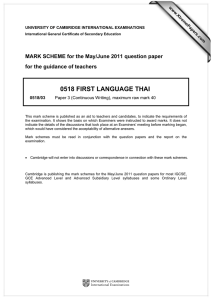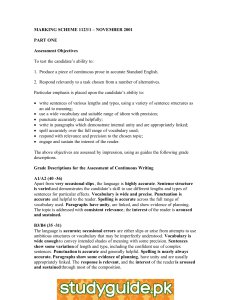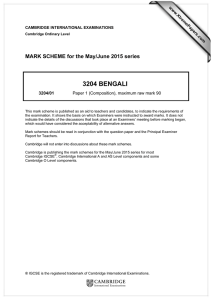3204 BENGALI MARK SCHEME for the May/June 2011 question paper
advertisement
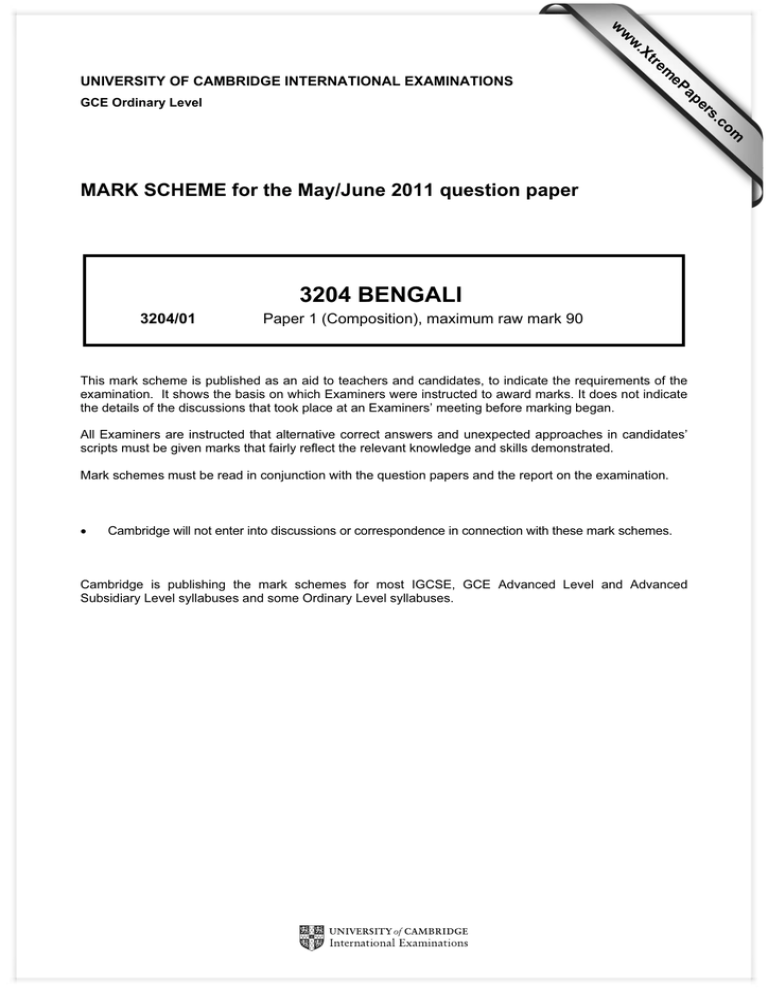
w w ap eP om .c s er GCE Ordinary Level m e tr .X w UNIVERSITY OF CAMBRIDGE INTERNATIONAL EXAMINATIONS MARK SCHEME for the May/June 2011 question paper 3204 BENGALI 3204/01 Paper 1 (Composition), maximum raw mark 90 This mark scheme is published as an aid to teachers and candidates, to indicate the requirements of the examination. It shows the basis on which Examiners were instructed to award marks. It does not indicate the details of the discussions that took place at an Examiners’ meeting before marking began. All Examiners are instructed that alternative correct answers and unexpected approaches in candidates’ scripts must be given marks that fairly reflect the relevant knowledge and skills demonstrated. Mark schemes must be read in conjunction with the question papers and the report on the examination. • Cambridge will not enter into discussions or correspondence in connection with these mark schemes. Cambridge is publishing the mark schemes for most IGCSE, GCE Advanced Level and Advanced Subsidiary Level syllabuses and some Ordinary Level syllabuses. Page 2 Mark Scheme GCE O LEVEL – May/June 2011 Syllabus 3204 Paper 01 Section A Question 1 and 2 Content marks per bullet point (max. mark for content = 4 bullet points × 3 marks = 12 marks): MARKS CONTENT 3 Bullet point is addressed in full. 2 Bullet point is addressed in part or mentioned in passing. 1 Bullet point is addressed but insufficiently understood or misinterpreted. 0 Bullet point is not addressed anywhere in the composition. © University of Cambridge International Examinations 2011 Page 3 Mark Scheme GCE O LEVEL – May/June 2011 Syllabus 3204 Paper 01 Language marks for Question 1 and 2: BAND MARKS LANGUAGE • 1 16–18 • • 2 13–15 • • 3 10–12 • • 4 7–9 • • 5 4–6 • • 6 0–3 • • The language is accurate; occasional slips are either slips or arise from attempts to use ambitious structures or vocabulary. Vocabulary is appropriate and wide enough to convey shades of meaning with precision. Sentences are varied in length, including the confident use of complex sentences. Spelling is nearly always accurate. Paragraphs are effectively sequenced and appropriately linked. The response is concise, staying within the word limit. Punctuation is accurate and helpful. The meaning is generally clear. Vocabulary and structures are mainly correct when they are simple; mistakes may occur when sophistication is attempted. Sentences may show some variety of structure and length, although there may be a tendency to repeat sentence types and ‘shapes’. Spelling is generally accurate, but mistakes may occur when more ambitious vocabulary is used. Sentence separation is correct. The composition is written in paragraphs which mostly show unity, although some links may be absent or inappropriate. The composition stays within the word limit or only exceeds it to a limited extent. Punctuation is generally accurate and helpful, apart from occasional slips. The meaning is generally clear. There will be patches of accurate language, particularly when simple vocabulary and structures are used. There may be some variety of sentence length and structure, but this variety may not always be effective. Vocabulary is usually adequate to convey intended meaning although it may not be sufficiently developed to convey precision. Idiom may be uncertain at times. Sentence separation errors may occur occasionally. Simple words may be accurately spelt, but there may be weaknesses in the spelling of more complex words. Paragraphs may be used but may lack coherence. Punctuation may be used but will not enhance or clarify meaning. Meaning is never in doubt, but the errors are sufficiently frequent and serious to hamper precision and may slow the speed of reading. Some simple structures will be accurate, but the candidate is unlikely to sustain accuracy for long. Vocabulary may be limited. Idiomatic errors are likely. Simple words will usually be spelt correctly, but there may be inconsistency and frequent mistakes in the spelling of more difficult words. Paragraphs may lack unity or be used haphazardly, or may not even be used at all. Linguistic errors are likely to distract the reader from merits of content. Simple punctuation may be accurate, but there may be frequent separation errors. There may be serious errors of various kinds throughout the answer which may blur communication from time to time. Sentences will be simple and repetitive in structure. Vocabulary may convey meaning but is likely to be simple and imprecise. Errors in idiomatic usage will be a significant feature. Spelling may be inconsistent, including in simple words. Paragraphing may be haphazard or non-existent. Linguistic error is likely to obscure or neutralise meaning. Sense may be decipherable, but errors will require the reader to re-read and reorganise before any meaning is clear. There are unlikely to be more than a few accurate sentences. Content will be partly or mostly hidden by linguistic error. At the lower end, answers will not be identifiable as pieces of Bengali writing and whole sections will no sense at all. The mark of 0 is reserved for answers that make no sense at all from beginning to end. © University of Cambridge International Examinations 2011 Page 4 Mark Scheme GCE O LEVEL – May/June 2011 Syllabus 3204 Paper 01 Section B Band Descriptors for Question 3, 4 and 5 BAND 1 2 3 4 MARKS DESCRIPTORS 54–60 • Apart from very occasional slips, the language is accurate. Sentence structure is varied and demonstrates the candidate’s skill to use different lengths and types of sentences for particular effects. Vocabulary is wide and precise. • Punctuation is accurate and helpful to the reader. Spelling is accurate across the full range of vocabulary used. Paragraphs have unity, are linked, and show evidence of planning. The topic is addressed with consistent relevance; the interest of the reader is aroused and sustained. 47–53 • The language is accurate; occasional errors are either slips or arise from attempts to use ambitious structures or vocabulary that may be imperfectly understood. Vocabulary is wide enough to convey intended shades of meaning with some precision. Sentences show some variation of length and type, including the confident use of complex sentences. • Punctuation is accurate and generally helpful. Spelling is nearly always accurate. Paragraphs show some evidence of planning, have unity and are usually appropriately linked. The response is relevant, and the interest of the reader is aroused and sustained through most of the composition. 39–46 • Vocabulary and structures are mainly correct when they are simple; mistakes may occur when more sophistication is attempted. Sentences may show some variety of structure and length, although there may be a tendency to repeat sentence types and ‘shapes’, producing a monotonous effect. Spelling of simple vocabulary is accurate; errors may occur when more ambitious vocabulary is used. • Punctuation is generally accurate, although errors may occur when more difficult tasks are attempted e.g. the punctuation of direct speech. Sentence separation is correct. The composition is written in paragraphs which may show some unity, although links may be absent or inappropriate. The composition is relevant and will arouse some interest in the reader. 31–38 • The meaning is generally clear. There will be patches of accurate language, particularly when simple vocabulary and structures are used. There may be some variety of sentence length and structure, but the reader may not be convinced that this variety is for a particular purpose. Vocabulary is usually adequate to convey intended meaning, although it may be insufficiently developed to achieve precision. Idiom may be uncertain at times. • Punctuation will be used but may not enhance/clarify meaning. Some sentence separation errors may occur occasionally. Simple words will be spelt accurately, but more complex vocabulary may show some spelling weakness. Paragraphs will be used but may lack unity or coherence. A genuine attempt has been made to address the topic, but there may be digressions or failures of logic. Compositions may lack liveliness and interest value. © University of Cambridge International Examinations 2011 Page 5 5 6 7 8 Mark Scheme GCE O LEVEL – May/June 2011 Syllabus 3204 Paper 01 23–30 • Meaning is never in doubt, but the errors are sufficiently frequent and serious to hamper precision, and may slow down speed of reading. Some simple structures will be accurate, but the script is unlikely to sustain accuracy for long. Vocabulary may be limited, either too simple to convey precise meaning or more ambitious but imperfectly understood. Some idiomatic errors are likely. • Simple punctuation will usually be accurate, but there may be frequent sentence separation errors. Simple words will usually be spelt correctly, but there may be inconsistency, and frequent mistakes in the spelling of more difficult words. Paragraphs may lack unity or be used haphazardly. The subject matter will show some relevance. The incidence of linguistic error is likely to distract the reader from merits of content. 15–22 • There will be many serious errors of various kinds throughout the script, but they will be of the ‘single-word’ type i.e. they could be corrected without re-writing the sentence. • Communication is established, although the weight of error may cause ‘blurring’ from time to time. Sentences will probably be simple and repetitive in structure. Vocabulary will convey meaning but is likely to be simple and imprecise. Errors in idiomatic usage will be a significant feature. • Spelling may be inconsistent. Paragraphing may be haphazard or nonexistent. There may be evidence of interesting and relevant subject matter, but the weight of linguistic error will tend to obscure or neutralise its effect. 7–14 • Sense will usually be decipherable but some of the error will be multiple i.e. requiring the reader to re-read and re-organise before meaning becomes clear. There are unlikely to be more than a few accurate sentences, however simple, in the whole composition. • The content is likely to be comprehensible, but may be partly hidden by the density of the linguistic error. 0–6 • Scripts are entirely, or almost entirely impossible to recognise as pieces of Bengali writing. Whole sections will make no sense at all. Where occasional patches of relative clarity are evident some marks will be given. • The mark of 0 is reserved for scripts that make no sense at all from beginning to end. © University of Cambridge International Examinations 2011
